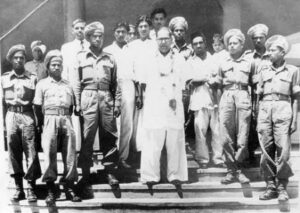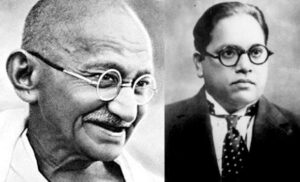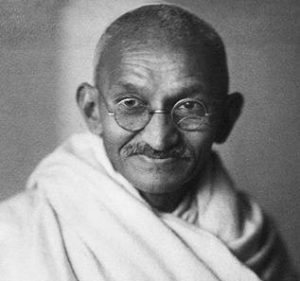
Bhimrao Ramji Ambedkar
Bhimrao Ramji Ambedkar (1891-1956) became the champion of Dalits, a category known by various identity tags, including outcastes and “untouchables.” His resistance to the caste system of Hinduism was a significant feature of twentieth century Indian political and social events.
Mahar Background
Born at Mhow cantonment, near Indore in Madhya Pradesh, Ambedkar was the son of Ramji Sakpal, a Mahar (Dalit). This pater was headmaster of a military school for many years, educating the children and relatives (including women) of military personnel. Sakpal gained the rank of an officer, more specifically subhedar (Jaffrelot 2005:19ff). That status (often dubbed Major) was the second highest ranking available to Indian officers in the British Indian army. The family of Ambedkar’s mother also included “subhedar Majors.” A subhedar was generally familiar with the English language, even in a rudimentary form. Sakpal seems to have been unusually literate in the Hindu scriptures; he was an acquaintance of the shudra reformist Jyotiba Phule.
The Mahar family of Ambedkar had for many years participated in the forces of the opportunist British East India Company. Mahars were recruited into the British armies from the 1750s. Indeed, Mahars may have comprised a quarter of the entire Bombay Army, being famed for their loyalty. Much earlier, the Maratha leader Shivaji Bonsale I (rgd 1674-80) included Mahars in his army (Mahar movement’s military component).
Unlike the Bhangis of North India, the Mahars did not clean latrines (Jaffrelot 2005:172 note 6). They were the most educated sector of Dalits, often inclined to leave the hostile villages where the majority were caste Hindus. Untouchables were obliged to live in unhygienic conditions on the outskirts of villages and towns. Being denied the use of public wells, they were “condemned to drink any filthy water they could find” (Keer 1971:1).
The influential eighteenth century Peshwa brahman rulers of Maharashtra sternly applied caste injunctions. Dalits had to carry a broom on their back to erase their polluting footprints. They had to wear a pot around their neck for the purpose of collecting any polluting spittle. Education was banned for these victims of high caste oppression. If any Dalits (Mahars) rebelled at such imposition, they were killed by the vengeful brahman caste.
The Peshwas sanctioned the burial alive of Mahars and Mangs (also untouchables) in the foundations of forts and mansions. The elite brahmans would make these victims drink oil mixed with red lead. Decapitation was another punishment. A Mang report, published in 1855, describes some crimes of high caste oppression (Mukta Salve, Grief of Mangs and Mahars).
In more general terms, the Maratha invasion of West Bengal committed atrocities recorded by both Bengali and European sources. Maratha leaders would torture and kill those Bengalis unable to make the payments exacted. Some sources state that hundreds of thousands in Bengal were killed by the Maratha Empire soldiers. To the south, many Mahars welcomed the British, whose army they joined without the acute discrimination formerly encountered. The family of Ambedkar was one instance.

Dr. Ambedkar with the Mahar Regiment raised in 1941
Originally, Mahars were village servants, street sweepers, wall-menders, caretakers of cremation grounds, and removers of dead cattle. With the arrival of the British, some Mahars left their villages and found work in cities and the army. In Maharashtra, by the 1960s, Mahars comprised about seventy percent of the Dalit population, and about nine percent of the state population (Junghare 1988:93).
Early Education
As a consequence of cantonment life, Ambedkar was sheltered from caste discrimination during his early years. However, he found that no barber would cut his hair. A stationmaster abruptly retreated upon learning of his background (Jaffrelot 2005:2). Ambedkar’s literate military father nevertheless gained access to a school for his son. This event was assisted via changes made by the colonial administration. In 1900, Ambedkar entered the Government school at Satara, where he was the only untouchable pupil. He had to sit on the floor by himself in a remote corner. Nobody could speak to him. A generous teacher would daily give him food; the other pedagogues were far more aloof.
Schoolteachers (often brahmans) were generally reluctant to communicate with untouchables. At school, Ambedkar was subject to segregation from caste Hindu children. He was not permitted to touch the water tap; only a caste entity could do so. At this period, when untouchable children needed to drink water, a caste Hindu would pour the liquid from a height over their heads; they were not allowed to touch the water or the container, being considered a source of defilement. If a willing caste Hindu was not available to assist, these children had to endure thirst. In many ways, high caste Hindus opted to emphasise the formidable gap between themselves and the despised untouchables.
Ambedkar’s family moved to Bombay (Mumbai). In 1906, at the age of fifteen, he was married to the nine year old girl Ramabai. Neither of them had any choice in this arranged marriage, a prevalent custom sanctioned by the Manusmriti and other legal texts. In 1907, the boy gained a matriculation certificate at the elevated Elphinstone High School. Ambedkar was thereafter the first Dalit to be enrolled at Elphinstone College and Bombay University. In 1912 he gained a BA degree in economics and political science from the University.
Academic Studies and Dalit Rights
He gained the assistance of the liberal Maharaja of Baroda, meaning Sayaji Rao Gaekwad III (rgd 1875-1939). This Maratha aristocrat boldly abolished child marriage, opened schools for girls, and campaigned for the entry of untouchables into temples. The Gaekwad also awarded Ambedkar a Baroda State scholarship, enabling this young scholar to move to America in 1913. Studying at Columbia University, in New York, Ambedkar is often said to have been influenced by the output of pragmatist philosopher John Dewey (1859-1952), “arguably the most prominent American intellectual for the first half of the twentieth century” (Stanford Encyclopedia of Philosophy). Ambedkar himself claimed three gurus as inspiration: Gautama Buddha, Kabir, and the reformist Jyotiba Phule (1827-1890). Phule was a distinctive shudra of Maharashtra who resisted high caste domination.
Achieving an MA degree in 1913, Ambedkar subsequently registered at the London School of Economics (LSE) for a further distinction. Facilities in London were considered more desirable. In 1916, he presented his paper Castes in India, the venue being an anthropology seminar at Columbia University. The subject was long overdue for appropriate investigation, lacking clarity in the preferred obscurantism of high caste society. Ambedkar emphasised that the superimposition of endogamy on exogamy means the formation of caste. Caste created sati (widow burning), enforced widowhood, and child marriage. “Strict endogamy could not be preserved without these customs” (Ambedkar 1917). He was sceptical of a commemoration of sati by A. K. Coomaraswamy (1877-1947), who found “proof of the perfect unity of body and soul” between husband and wife. The “perennial philosophy” (a theme associated with Coomaraswamy) is hazardous.
The outbreak of World War One caused disruption to Ambedkar’s plans. He moved to London to study law at Grays Inn. However, Ambedkar was now recalled to India, serving as a military secretary at Baroda. Thereafter, he became a Professor of Political Economy at Sydenham College, Bombay. Again he encountered the ubiquitous caste pride. High caste professors objected to his sharing a jug of drinking water with them, fearing contamination.
Ambedkar began to campaign for Dalit rights against the formidable bigotry. In 1920, he commenced a Marathi weekly newspaper which strongly criticised the high caste tactic. He spoke at two conferences convened by the liberal Maharaja of Kolhapur, Rajarshi Shahu Maharaj (rgd 1894-1922). Both of these events featured inter-caste dining arrangements that were taboo to conservatives. The Maharaja was influenced by Jyotiba Phule, and himself gained the repute of a social reformer, being sympathetic to low castes. This Maratha ruler granted untouchables access to public utilities, including wells. He legalised inter-caste marriage and widow remarriage. Rajarshi Shahu admired the intellect of Ambedkar, whom he first met in 1917.
The Maharaja assisted Ambedkar’s return to London in 1920. Three years later, the Mahar scholar gained a doctorate in economics from LSE in 1923. Ambedkar also received royal support for legal training at Gray’s Inn. Returning to Bombay in 1924, the academic Dalit intensified his project for social reform. He now gained the status of a professional legalist, though finding a difficulty in gaining clients because of caste bias (Jaffrelot 2005:4). However, Ambedkar was nominated by the British to the Legislative Council of Bombay Presidency. While working in Bombay High Court, he promoted the education of his fellow Dalits, then known as the Depressed Classes.
By 1927, he was inspiring a Dalit march to gain public drinking water rights, opposing the inhuman policy of denying the outcastes any access to public wells. Ambedkar was also keen to claim Dalit rights to enter Hindu temples. These incentives were strongly resisted by high caste factions.
In March 1927, Ambedkar led hundreds of Dalits to drink at a forbidden water tank in Mahad, a town located in the Konkan, a coastal region of Maharashtra (and Ambedkar’s ancestral territory). He defiantly drank water at the tank (Kundu 2018:xiv). Local caste Hindus filed multiple court cases, affirming that the water tank was private property and not accessible to Dalits.
Manusmriti
At the end of 1927, the Dalit champion condemned the Manusmriti (Laws of Manu), a prestigious text providing ideological justification for caste discrimination. Ambedkar resorted to a ceremonial burning of this afflicting document. On 25 December, 1927, thousands gathered at Mahad. The mood was one of reaction to the suppression of shudras and women expressed in Manusmriti. Women had a social status equivalent to nil, even if they were high caste. With a few other Dalits, Ambedkar publicly burned a copy of the detested legal text at Mahad. This defiant action represented a denial of female inferiority, child marriage, and social stigma of Dalits.
The approximate date of Manusmriti is the period between the second century BC and the second century CE (Olivelle 2004:xxiii). This verse text was hugely influential in Hindu society, Manu being regarded as a divine lawgiver. Some analysts believe that the text represents the output of many writers. The Manusmriti definitely restricts women and the lower castes, glorifying the elite social classes known as brahmans (priests) and kshatriyas (aristocrats), more especially the former.
The earlier law texts, known as Dharmasutras, were written in prose as scholarly works (Olivelle 1999). Opposing viewpoints were here presented. In contrast, the Manusmriti is a dogmatic text in verse, with no debate possible. Manu is here a “primeval lawgiver, the Creator himself” (Olivelle 2004:xxv). The Manusmriti “seeks to present itself as an eternal document parallel to the Vedas and composed by the Creator himself” (ibid:xl). A verse text was considered superior to prose by the brahmans.
The discussion of the vaishya and shudra categories, in the now contested Manusmriti, is “extraordinarily brief” (ibid:xxxv). A mere eight verses are given to the marginalised vaishya (farmer, trader) and only two to the shudra (labourer, artisan). Some analysts deduce a reaction to Buddhism of the Mauryan era, a period associated with shudra rulers. Buddhist and Jain ascetics were resented by the brahmans. “The connection between Shudra and the non-Brahmanical ascetic sects [Buddhism and Jainism] is drawn by Manu himself” (ibid:xliv). The reference is to Manusmriti 4:61, where “heretical ascetics” are mentioned.
Draconian punishment, prescribed by the legal canon, includes a well known reference found in the Gautama Dharmasutra. If the low class man listened to recitation of a sacred priestly text, then molten lead must be poured into his ears. The marginalised classes were denied education and literacy, remaining totally ignorant of scripture.
Born as a Hindu, but will not die as a Hindu
In March 1930, Dr. Ambedkar launched the Kalaram Temple movement, lobbying for Dalit entry to Hindu temples. He endorsed a non-violent procession at Nasik, comprising thousands of Dalit volunteers (including women). When the procession reached the entrance of the famed Kalaram temple, the gates were closed by vehement brahman leaders denying access. The untouchables could not participate in Hindu caste religion. For centuries, they had not been able to enter the temples.
Caste Hindus resorted to violence, enlisting the police in their strategy. The harsh treatment was extended to Dalits of nearby villages at Nasik. Children were expelled from school, roads were closed to hinder Dalit movements, Dalits were banned from the local market where they need to obtain food. Many Dalits were arrested. Ambedkar ensured that the victims did not retaliate, knowing that further problems would result.
The aggressive high caste insularists are an ugly feature of the Indian landscape, totally belying the image of an “enlightened religion of meditation.” The manic resistance led Ambedkar to declare in 1935 (at Yeola) that he was “born as a Hindu, but will not die as one.” Those famous words are now associated with his eventual conversion to Buddhism.
Ambedkar and Gandhi
In 1932, the British colonial government announced the formation of a separate electorate for “depressed classes” in their Communal Award. This Award was created that year by the Prime Minister Ramsay Macdonald (1866-1937). The Award was interpreted by some as favouring minorities over the Hindus, the minorities being Muslims, Sikhs, Buddhists, Indian Christians, Anglo-Indians, and others. Mahatma Gandhi (1869-1948) strongly reacted to the Award; he was then located in Yeravda jail (Poona). Fearing that the Award would cause the disintegration of Hindu society, he undertook a fast. In contrast, Ambedkar favoured the Award (Jaffrelot 2005:52ff).

Mahatma Gandhi and Dr. Ambedkar
After subsequent and lengthy negotiations, Ambedkar conceded an agreement with Gandhi for a single Hindu electorate, with “scheduled castes” having seats reserved within this arrangement. This was the Poona Pact of September 1932, occurring at Yeravda jail. Subsequently, Ambedkar resisted the term Harijan, favoured by Gandhi to describe untouchables. The designation “children of God” was regarded by Ambedkar as a condescending gesture that fixed the depressed classes within the boundary of Hinduism (Kundu 2018:xv).
Ambedkar later wrote the book What Congress and Gandhi have done to the Untouchables (1945). The author frequently criticised and condemned Gandhi during the latter’s lifetime and after. Whereas Gandhi continually expressed respect for Ambedkar, even insisting that Nehru include him in the Cabinet. One perspective is that Ambedkar represented Mahars to the extent that he lost the goodwill of other Dalit groups whom Gandhi collectively called Harijans (Chavan 2012; Chavan 2016).
The book Annihilation of Caste (1936) was originally a speech of Ambedkar, strongly worded. An anti-caste organisation in Lahore rejected the pending speech at their premises, fearful of orthodox wrath. They wanted Ambedkar to remove some passages. However, he refused to alter a single word. The author accordingly self-published the speech. The content included a criticism of Gandhi. Twenty years later, in 1955, during a BBC interview Ambedkar accused Gandhi of a contradictory standpoint: opposing the caste system in English language output, while supporting caste in Gujarati writings.
Nehru’s Law Minister
Settling in Bombay, the minority politician Ambedkar stocked his personal library with more than 50,000 books. A very literate modernist, he pointed out the contradiction posed by a well known Vedantic theme of the all-pervading Brahma (Brahman); the dire stigma of untouchability does not enhance traditionalist claims. In 1935, Ambedkar presided at the significant Yeola Conversion Conference, where he advised Dalits to abandon all agitation for temple entry concessions, in the face of persistent high caste hostility. Instead, he resolved that Dalits should leave Hinduism. “Within a month a group of young untouchable men gathered in Nasik to burn a copy of Manu ceremonially” (Olivelle 2004:xvii). In 1936, Ambedkar created the Independent Labour Party.
In his book The Untouchables (1948), Ambedkar boldly described Hinduism as “a diabolical contrivance to suppress and enslave humanity.” He stated: “Today all scholarship [in India] is confined to the Brahmins.” He complained that there was no Voltaire amongst them. Ambedkar also emphasised that the modern Hindus perceived the wrong involved in caste, but were ashamed to discuss the topic “for fear of letting the foreigner know that Hindu civilisation can be guilty of such a vicious and infamous system or social code as evidenced by untouchability.” He observed that Europeans had also neglected the subject.
Ambedkar did not ignore Muslims in his output. In his lengthy Thoughts on Pakistan (1945), he argued that Hindus should concede Pakistan to the Muslims. This fraught subject aroused controversy. He subsequently criticised the mistreatment of women in Muslim society, while objecting to the Muslim version of a caste system. Islam had not abolished slavery.
In 1947, the new post-British government of India, led by Jawaharlal Nehru (1889-1964), invited Ambedkar to serve as their first Law Minister. Accepting the office, he was soon appointed to compose the new Constitution of India. In this document, he argued for substantial economic and social rights on behalf of women. He also argued for civil liberties and the abolition of untouchability. In 1949, the Constitution was rendered official.
In 1951, he resigned from the Cabinet when Parliament obstructed his draft of the Hindu Code Bill, which accommodated gender equality in the laws of inheritance and marriage. Conservative male Hindu politicians were in opposition, refusing to pass the Women’s Rights Bill. These men were largely from the Congress party of Nehru, who distanced himself from Ambedkar to avoid alienating Hindu conservatives.
Ambedkar was “a rare courageous individual who dared critique nationalism at the height of India’s nationalist movement.” He remarked to Gandhi: “I have no country.” Furthermore, he “combined fearless and trenchant criticism of religion with deep sympathy and understanding of it.” The doctrine of karma is often a stumbling block for moderns. Whereas Ambedkar “proposed a revised theory of karma to imply that every action had an inescapable consequence, however delayed or deferred it might be” (quotes from Prathama Banerjee, Ambedkar’s Rethinking of Religion, 2017).
Riddles in Hinduism
Riddles in Hinduism was one of his posthumously published works. This book is very critical of Hindu religious texts, contending that the brahmans imposed the caste system, thereby exploiting the lower classes. When the book was published thirty years after his death, Hindu orthodoxy in Maharashtra attempted a ban. In the introduction, the author reflects:
The Brahmins have propagated the view that the Hindu civilisation is Sanatan, that is, unchanging. This view has been reinforced by a good many of the European scholars who have said that the Hindu civilisation is static. In this book I have attempted to show that this view is not in accord with the facts and that Hindu society has changed from time to time and that often times the change is of the most radical kind. (Ambedkar 1987:5)
One of the “riddles” emphasised by Ambedkar was a question of why the brahmans declared the Vedas to be infallible. He concludes that the Vedas were not regarded as authoritative until the time of Gautama. The priests then achieved a role of sole authority by creating a belief in infallible texts. “They introduced fear in the minds of people by saying that if they did not follow the rules of the Vedas and work according to what the Brahmins say, they would be deprived of the joys of heaven.”
Conversion to Buddhism
Other Dalit castes, such as the Mangs and Chambars, became jealous of the increased prominence gained by Mahars (who included Ambedkar). A common front failed amongst both Dalits and lower castes (Jaffrelot 2005:162). In another direction, the nationalist Hinduism of independence India was a huge problem. As a consequence, Ambedkar resolved to embrace Buddhism, in a distinctive manner evading the well known ideologies of Theravada and Mahayana (Jondhale and Belz 2004).
Ambedkar initially considered converting to Sikhism, but by 1950 he was serious about Buddhism. He converted to his own version of Buddhism in October 1956, at Nagpur, shortly before his death. His example inspired 380,000 Dalits to become converts to what he called Navayana Buddhism. This variant is also called Neo-Buddhism.
Hathras Rape Case
The disgraceful relegation of Dalits has continued in many regions of India, despite official gestures to the contrary. A decade after the death of Ambedkar, in the late 1960s commenced the lavish Western enthusiasm for commercial Hindu gurus. The lore about India was mystifying. The new devotees were unable to discern the true situation at large.
One of the most well known instances of Dalit abuse occurred in 2020, at Hathras District, Uttar Pradesh (Hathras Rape Case). A nineteen year old Dalit girl was gang-raped and brutally assaulted by high caste neighbours. Her spine was broken by the rapists; she was bleeding and vomiting blood. She died in hospital. The corrupt police forcibly cremated her body in darkness without her family’s consent. The Supreme Court provided paramilitary protection for the bereaved family, in view of a concern that they could be targeted by high caste Hindus. Murderous high caste thugs and rapists (including police thugs) are one reason to reject elitist claims.
Bibliography:
Ambedkar, Bhimrao R., “Castes in India: Their Mechanism, Genesis and Development,” Indian Antiquary (1917), Vol. XLVI.
——–Annihilation of Caste (1936)
——–Pakistan or the Partition of India (1945)
——–What Congress and Gandhi have done to the Untouchables (1945)
——–Who were the Shudras? (1946)
——–The Untouchables: Who Were They? And Why They became Untouchables (1948)
——–The Buddha and the Dhamma (1957)
——–Riddles in Hinduism (1987)
——–Waiting for a Visa (1990)
——–Ambedkar: An Overview (New Delhi: Rupa, 2018).
Chavan, Sheshrao, The Betrayal of Dr. Babasaheb Ambedkar (New Delhi: Authorspress, 2012).
——–Congress, Gandhi and Ambedkar: Assessment and Observations of Untouchability (New Delhi: Authorspress, 2012).
——–True Faces of Gandhi and Ambedkar (New Delhi: Atlantic Publishers, 2016).
Jaffrelot, Christophe, Dr. Ambedkar and Untouchability: Fighting the Indian Caste System (Columbia University Press, 2005).
Jondhale, Surendra, and Johannes Belz, eds., Reconstructing the World: B. R. Ambedkar and Buddhism in India (Oxford University Press, 2004).
Junghare, Indira Y., “Dr. Ambedkar: The Hero of the Mahars, Ex-Untouchables of India,” Asian Folklore Studies (1988) 47(1):93-121.
Keer, Dhananjay, Dr. Ambedkar: Life and Mission (1954; third edn, Bombay: Popular Prakashan, 1971).
Kundu, Abhijit, introduction to Ambedkar : An Overview (New Delhi: Rupa, 2018).
Moon, Vasant et al, eds., Dr. Babasaheb Ambedkar: Writings and Speeches (17 vols, Bombay: Education Department, Government of Maharashtra, 1979-).
Olivelle, Patrick, trans., The Dharmasutras: The Law Codes of Ancient India (Oxford University Press, 1999).
——–trans., The Law Code of Manu (Oxford University Press, 2004).
Zelliot, Eleanor, From Untouchable to Dalit: Essays on the Ambedkar Movement (New Delhi: Manohar, 1992).
——–Ambedkar’s World: The Making of Babasaheb and the Dalit Movement (New Delhi: Navayana, 2013).
Kevin R. D. Shepherd
ENTRY no. 79
Copyright © 2021 Kevin R. D. Shepherd. All Rights Reserved.


